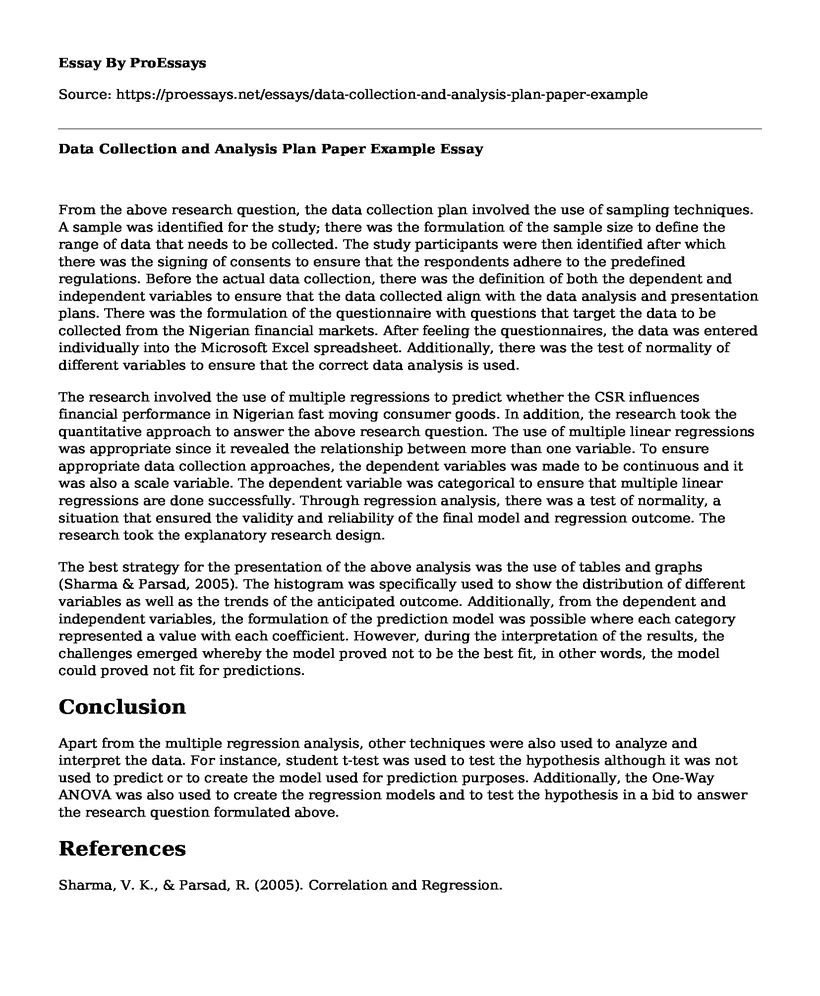From the above research question, the data collection plan involved the use of sampling techniques. A sample was identified for the study; there was the formulation of the sample size to define the range of data that needs to be collected. The study participants were then identified after which there was the signing of consents to ensure that the respondents adhere to the predefined regulations. Before the actual data collection, there was the definition of both the dependent and independent variables to ensure that the data collected align with the data analysis and presentation plans. There was the formulation of the questionnaire with questions that target the data to be collected from the Nigerian financial markets. After feeling the questionnaires, the data was entered individually into the Microsoft Excel spreadsheet. Additionally, there was the test of normality of different variables to ensure that the correct data analysis is used.
The research involved the use of multiple regressions to predict whether the CSR influences financial performance in Nigerian fast moving consumer goods. In addition, the research took the quantitative approach to answer the above research question. The use of multiple linear regressions was appropriate since it revealed the relationship between more than one variable. To ensure appropriate data collection approaches, the dependent variables was made to be continuous and it was also a scale variable. The dependent variable was categorical to ensure that multiple linear regressions are done successfully. Through regression analysis, there was a test of normality, a situation that ensured the validity and reliability of the final model and regression outcome. The research took the explanatory research design.
The best strategy for the presentation of the above analysis was the use of tables and graphs (Sharma & Parsad, 2005). The histogram was specifically used to show the distribution of different variables as well as the trends of the anticipated outcome. Additionally, from the dependent and independent variables, the formulation of the prediction model was possible where each category represented a value with each coefficient. However, during the interpretation of the results, the challenges emerged whereby the model proved not to be the best fit, in other words, the model could proved not fit for predictions.
Conclusion
Apart from the multiple regression analysis, other techniques were also used to analyze and interpret the data. For instance, student t-test was used to test the hypothesis although it was not used to predict or to create the model used for prediction purposes. Additionally, the One-Way ANOVA was also used to create the regression models and to test the hypothesis in a bid to answer the research question formulated above.
References
Sharma, V. K., & Parsad, R. (2005). Correlation and Regression.
Cite this page
Data Collection and Analysis Plan Paper Example. (2022, Jul 01). Retrieved from https://proessays.net/essays/data-collection-and-analysis-plan-paper-example
If you are the original author of this essay and no longer wish to have it published on the ProEssays website, please click below to request its removal:
- Reforming the British House of Lords
- Big Data Analytics the Challenges and Opportunities
- Information Gathering Techniques Essay
- Evaluating Quantitative Design Paper Example
- Bibliographic or Reference Entry Essay
- Appraisal of the Methods Used for a Qualitative Study - Essay Sample
- Essay on Healthcare Practitioners: Data Analysis for Fall Prevention in Long-Term Care







